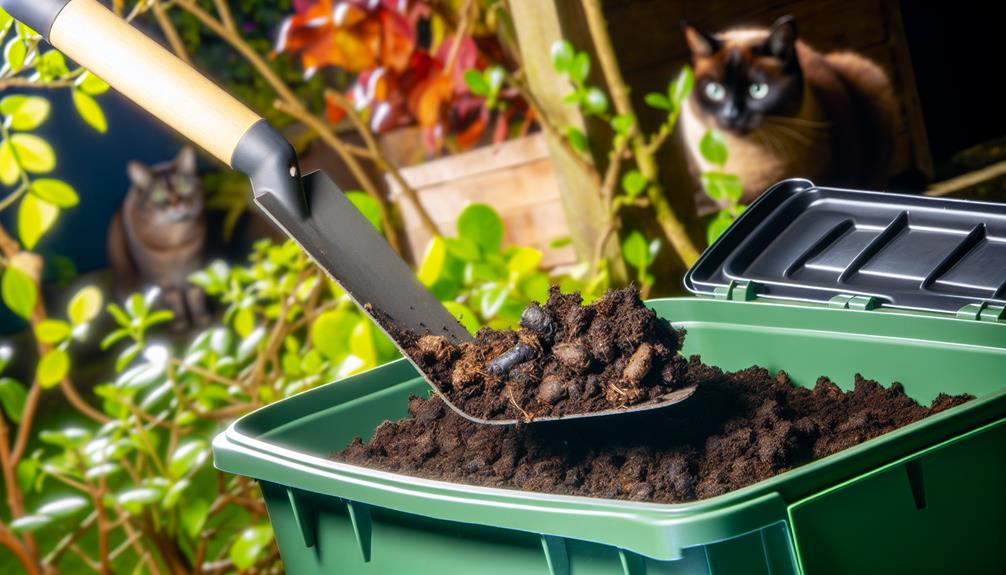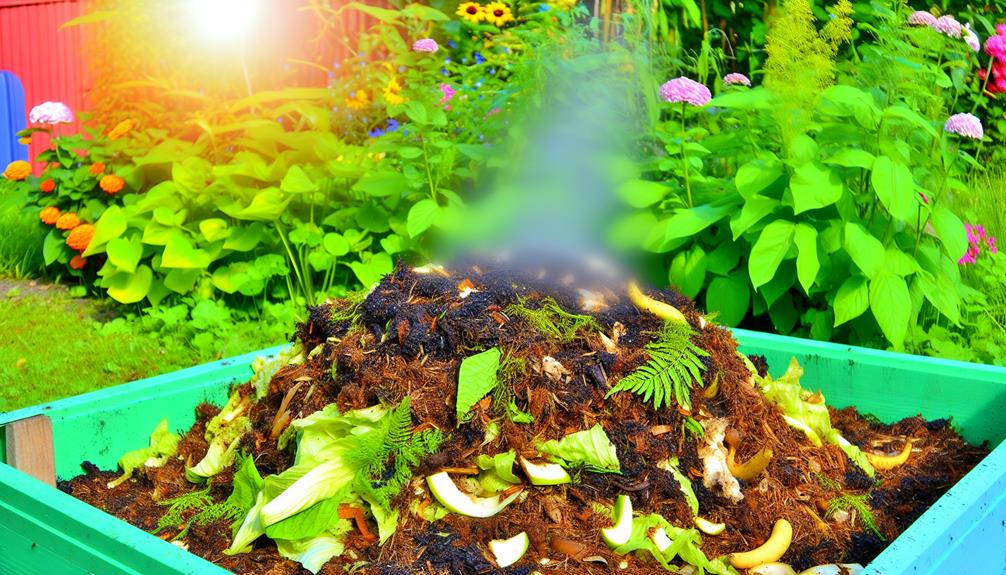

Yes, you can compost cat manure, but you’ll need to be cautious and patient! Vital high-temperature composting is important to kill harmful bacteria and parasites, like Toxoplasma gondii. Your compost needs to stay above 145°F for at least three days. Use biodegradable litter, such as pine or paper-based, which aids the process.
Maintain proper moisture, aeration, and mix your compost regularly. Let it sit for two years to guarantee safety. Remember, careful handling is required to prevent health risks. Stay safe and meticulous, and you’ll transform cat waste into useful compost, enriching your garden soil. Keep exploring to master this process!
Composting cat manure requires understanding its unique challenges and safety precautions. You’re not just dealing with typical compostable items; cat manure contains harmful bacteria that need careful handling.
High-temperature composting is essential to break down these bacteria, so maintaining the right conditions is vital. Make sure your compost pile has proper aeration, moisture, and regular mixing for effective decomposition.
Using pine- or paper-based litter helps in this process, as they’re more suitable for composting cat manure. Remember, patience is key—let your compost sit for at least two years to ensure it’s safe for use on non-edible plants.
Also Read: Can You Compost Basil?
You might be surprised to learn that composting cat manure can come with serious risks, including pathogen contamination and toxoplasmosis concerns.
Cat feces can contain harmful parasites like Toxoplasma gondii, which can survive in soil for up to 18 months, posing a health risk to humans, especially pregnant women and those with weakened immune systems.
Additionally, improper composting can negatively impact soil health, making it unsafe for growing edible plants.
Given the significant health risks, it’s vital to understand the pathogen contamination risk associated with cat manure. Cat manure can harbor dangerous pathogens, including the Toxoplasma gondii parasite, which can cause toxoplasmosis. This parasite’s eggs can survive in soil for up to 18 months, posing long-term contamination risks.
Here are some critical points to keep in mind:
Understanding these risks promotes safer composting practices.
It’s important to acknowledge the significant health risks posed by the Toxoplasma gondii parasite found in cat manure. This parasite presents serious toxoplasmosis concerns that can affect not only humans but also animals like pigs and cows. The eggs from cat litter can remain viable in soil for up to 18 months, posing long-term risks. Pregnant women face severe complications if infected, making it vital to handle cat litter with care.
Here’s a quick overview of the risks:
| Concern | Details |
|---|---|
| Health Risk | Toxoplasmosis from Toxoplasma gondii parasite |
| Viability Duration | Eggs last up to 18 months in soil |
| Affected Individuals | Humans, pigs, cows, and other animals |
| High-Risk Group | Pregnant women |
| Improper Composting Outcome | Spread of toxoplasmosis |
Taking these precautions can help ensure everyone’s safety and well-being.
Cat manure poses significant risks to soil health due to its harmful pathogens and bacteria. When you compost cat manure, you’re introducing elements that can harm your garden’s well-being. Here are four key risks to take into account:
Understanding these risks helps you maintain a healthy, thriving garden.
Also Read: Can You Compost Barbecue Sauce?
Maintaining temperatures above 145 degrees F for at least 3 days is essential for killing harmful pathogens and parasites present in cat manure. High-temperature composting guarantees your compost is safe and effective. This process is vital for eliminating harmful microorganisms, making it safe to use the resulting compost on non-edible plants.

By reaching and sustaining these high temperatures, you create an environment that breaks down dangerous elements, turning cat waste into a rich, useful fertilizer. You’ll need to monitor and manage the compost pile carefully, ensuring it remains hot enough throughout the process.
High-temperature composting might sound complex, but with diligence, you can transform cat manure into something beneficial for your garden and plants.
Choosing the right litter is essential for effective composting of cat manure and maintaining a safe, eco-friendly process. You’ll want to go for biodegradable options made from natural materials like pine, paper, corn, or wood, as these break down into harmless components.
Avoid clay-clumping litter since it doesn’t decompose and isn’t suitable for composting.
When composting cat manure, it’s important to select natural and biodegradable cat litter made from materials like corn, paper, or wood. This guarantees that your composting cat poop process is safe and effective. Natural materials break down easily, contributing to a healthier compost.
Here are some top choices for biodegradable cat litter:
Choosing the right cat litter makes you part of a community dedicated to sustainable living.
Choose chemical-free cat litter to guarantee that your composting efforts remain environmentally friendly and effective. Opt for biodegradable options like pine, paper-based, or other natural materials. Pine and paper-based litters break down naturally, enriching your compost pile without leaving harmful residues.
Biodegradable cat litter made from corn, paper, or wood is perfect for fostering a sustainable composting environment, aligning with your eco-friendly values.
Avoid clay-clumping litter, which contains sodium bentonite—a non-compostable mineral that disrupts the composting process. By choosing biodegradable cat litter, you’re taking a responsible step toward a greener future, ensuring that your cat’s waste contributes positively to your compost.
Together, we can create a cleaner, more sustainable world for everyone.
Also Read: Can You Compost Artichoke?
Maintaining the right moisture levels and aeration in your compost pile is essential for effectively breaking down cat manure. You want your compost pile to thrive, and achieving proper aeration plays a huge role in this. When your compost pile is well-aerated, odors are minimized, and decomposition speeds up.

To help you maintain these conditions, follow these steps:
Regularly mixing your compost pile is vital for effective aeration and heat distribution, guaranteeing the efficient breakdown of cat manure. Turning the pile helps prevent odors and keeps your compost well-balanced, which is essential when composting both cat and dog poop.
By mixing, you maintain ideal moisture levels and make sure all materials are exposed to heat, important for eliminating harmful pathogens. This process also prevents the pile from compacting, making it easier for microorganisms to work their magic. An efficiently mixed compost pile decomposes faster, turning waste into a nutrient-rich soil amendment.
Embrace the routine of regular mixing; it’s a simple step that brings you closer to achieving a thriving, sustainable compost system.
Properly composting cat manure requires a minimum of 2 years to make sure harmful bacteria and parasites are fully broken down. This extended composting period is vital to guarantee the safety and effectiveness of your compost cat project.
Here’s why taking this time matters:
Also Read: Can You Compost Baking Soda?
Using finished compost from cat manure can greatly enhance the health and vigor of your ornamental plants. When the compost is dark, crumbly, and earthy-smelling, you know it’s ready. Make sure it’s fully cured to eliminate harmful pathogens.
Apply this rich finished compost around your non-edible plants, and you’ll see the soil become more fertile and the plants thrive. Composting pet waste, especially from cats, can be a sustainable practice that adds valuable nutrients to your garden.
You can explore alternative composting methods, like vermicomposting with cat litter or the Bokashi fermentation process, to handle cat manure more effectively.

Vermicomposting uses worms to break down biodegradable cat litter and manure, creating nutrient-rich compost.
The Bokashi method, on the other hand, ferments the waste in an anaerobic environment, making it safe and easy to compost cat manure right in your home.
Vermicomposting with cat litter offers a sustainable way to turn cat manure into valuable compost for your garden. Using red worms, you can break down the litter and manure, transforming waste into nutrient-rich compost. This method isn’t only eco-friendly but also efficient.
Here’s how you can get started:
Explore the Bokashi fermentation process to efficiently compost cat manure while maintaining odors at bay. This anaerobic composting method uses beneficial microbes to break down cat poop.
You’ll need to layer the cat manure with bokashi bran, a special mix of microorganisms. This guarantees the waste ferments, neutralizing any unpleasant smells. Bokashi can handle pet waste by speeding up decomposition and reducing harmful pathogens.
After fermentation, you can add the material to traditional compost piles or bury it in soil, where it continues breaking down. Using Bokashi composting for cat poop is convenient and odor-free, turning pet waste into a nutrient-rich soil conditioner, enhancing your garden and creating a greener community.
Also Read: Can You Compost Aubergine?
When composting cat manure, make sure you’re always wearing gloves to protect yourself from harmful pathogens. Handling compost dog and cat feces requires extra caution to guarantee safety and effectiveness.
Follow these key steps:
Cat poop can take up to 2 years to decompose, depending on your composting conditions. Using high-temperature methods can speed up the process. Make sure you compost it properly to avoid harmful bacteria and use it for non-edible plants.
You shouldn’t use dog or cat waste as compost because it contains harmful bacteria, pathogens, and parasites like Toxoplasma gondii. These can contaminate your soil and plants, posing health risks to you and the environment.
Cat manure isn’t good for gardens because it contains harmful bacteria. You’d need high-temperature composting to make it safe. It’s best to compost cat manure for non-edible plants to avoid health risks.
The most environmentally friendly way to dispose of cat litter is to use biodegradable options like pine or paper-based litter. Composting these in a contained, aerated environment guarantees safe decomposition and minimal environmental impact.
By composting cat manure correctly, you’ll turn waste into valuable compost for non-edible plants, making your garden thrive.
Remember, it’s crucial to maintain high temperatures and choose the right litter to guarantee safety.
Keep the compost moist and aerated, and give it plenty of time to break down.
Using this nutrient-rich compost responsibly will benefit your garden while keeping you and your pets safe.
Embrace this eco-friendly practice, and watch your garden flourish!
